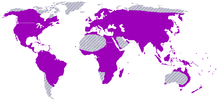
Back معتليات الشجر Arabic معتليات الشجر ARZ Epidendrumkimilər Azerbaijani Эпідэндравыя Byelorussian Епидендрови Bulgarian Epidendròidies Catalan Epidendroideae German Epidendroideae Spanish رودرختواران Persian Epidendroideae Finnish
| Epidendroideae | |
|---|---|

| |
| Epidendrum schomburgkii | |
| Scientific classification | |
| Kingdom: | Plantae |
| Clade: | Tracheophytes |
| Clade: | Angiosperms |
| Clade: | Monocots |
| Order: | Asparagales |
| Family: | Orchidaceae |
| Subfamily: | Epidendroideae Kostel. |
| Type genus | |
| Epidendrum L.[1] | |
| Tribes | |

| |
| Synonyms | |
|
Vandoideae | |
Epidendroideae is a subfamily of plants in the orchid family, Orchidaceae. Epidendroideae is larger than all the other orchid subfamilies together, comprising more than 15,000 species in 576 genera. Most epidendroid orchids are tropical epiphytes, typically with pseudobulbs. There are, however, some terrestrials such as Epipactis and even a few myco-heterotrophs, which are parasitic upon mycorrhizal fungi.
They typically contain the remaining orchids with a single, fertile anther ( = monandrous), which is also fully incumbent ( = strongly convex) to suberect (= ascending towards the edges). The anther form arises from column elongation or, as in the vandoids, from early anther bending. The incumbent anther forms a right angle with the column axis or is pointed backward in many genera. Most have hard pollinia, i.e. a mass of waxy pollen or of coherent pollen grains. The pollinia are with caudicle and viscidium or without. The stigma are entire or three-lobed; a beak is present. The apical part of the middle stigma lobe forms a stipe ( = pollinium stalk). The ovary is unilocular. The leaves are distichous or spiraling, growing on thickened stems.
The Epidendroideae are difficult to classify. They have been divided in “lower epidendroids” and “higher epidendroids”.
- ^ subfam. Epidendroideae Kostel. (n.d.). International Plant Names Index. Retrieved January 4, 2025, from https://www.ipni.org/n/330966-2